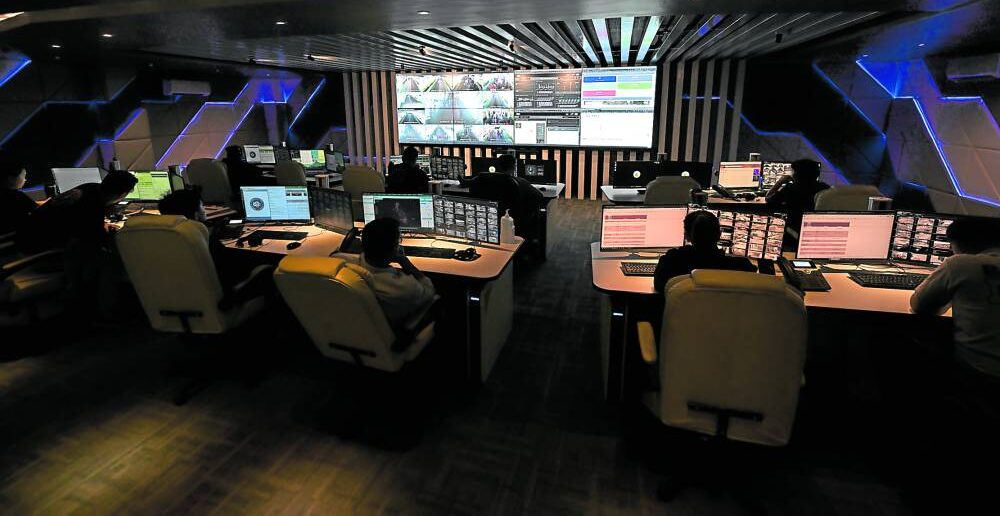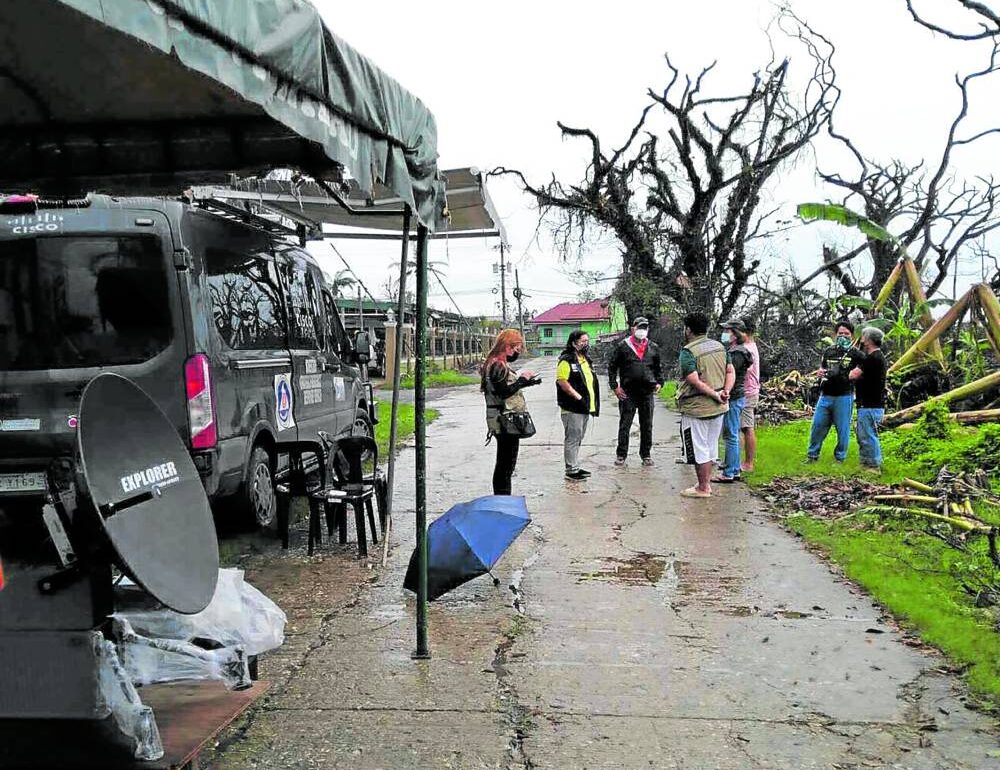Tech up to ease societal woes

In the aftermath of Supertyphoon “Odette” in December 2021, a gray van—unassuming on the outside but fully equipped with state-of-the-art technology—roamed across the ravaged areas of Visayas to help first responders communicate with teams on the ground.
The van carried LED monitors, network switches, routers and 4-mbps internet facility. It also featured voice-over internet protocol, capable of routing voice calls with telephone lines using satellite internet signal.
That van, after all, was the Konektado Strategic Emergency Response Vehicle (SERV) prototype of US-based digital communications and technology conglomerate Cisco.
“It’s a mobile command center that you can bring to areas that were hit by natural disasters and wherein they lost connectivity, power and communications,” Cisco Philippines managing director Zaza Nicart says in an interview with Inquirer. “Although it was still a prototype during that time, we deployed the SERV van in that area … to provide basic connectivity during the most critical hours postdisaster, and also for the responders to communicate back to their headquarters, provide updates and identify possible landing zones for the relief operations.”
Nicart recalls that the van even became the de facto office of the municipality of Trinidad in Bohol.
As Cisco also provided Wi-Fi, people gathered around the van to update their families and friends. They were also given sockets for cellphone charging.
By enabling communication, SERV thus also gave “hope for people,” Nicart adds.
Disaster resilience is one of the three pillars of Cisco’s Country Digital Acceleration (CDA) program for the Philippines, a country that has to grapple with at least 20 typhoons a year among other natural disasters.
Customized locally and launched in 2020 as “Ugnayan 2030,” CDA is a strategic partnership with government to help the national digital agenda. Aside from disaster resilience, the two other pillars of CDA are building smart cities and digital upskilling.
By supporting the digitalization agenda, Cisco also creates value for the country, for the industries and the citizens, she says.
“The CDA model is based on high degrees of trust and deep engagement across our ecosystem partners”—from the formation of project ideas all the way to execution, she explains. “We also work very closely in concert with the industry verticals, the academia, government leadership, to create a collaborative framework to solve societal issues or problems.”
DOH Telehealth
To support business continuity during the COVID-19 pandemic, Nicart notes that Cisco provided infrastructure and Webex videoconferencing licenses that in turn built the foundation for telehealth in the country under the Ugnayan 2030 program.
Cisco helped the Department of Health (DOH) in building capacity to conduct online consultations and virtual meetings, and to respond to large volumes of calls from patients all over the country via Cisco Webex licenses and devices. Hundreds of licenses were distributed to various health facilities.
“We supported them by integrating our collaboration solution with their electronic medical records solution. This way, the DOH was able to conduct online consultations and they were able to respond real-time or quickly to a large volume of calls during the pandemic,” Nicart says.
“You can just imagine the volume of online consultations as well as calls that the DOH was getting during that time. We helped them manage these,” Nicart says.
In 2020, DOH conducted 17,400 sessions over Webex, amounting to over 2.3 million minutes of meetings and consultations. Volume surged in 2021, during which DOH engaged with more than 100,000 stakeholders and patients on average per month.

Baguio command center
Another project close to Nicart’s heart is the smart city partnership with Baguio under Mayor Benjamin Magalong to address the looming “urban decay” flagged by a National Economic Development Authority study. The city teamed up with Cisco and Quantela to build a command center to address overcrowding, waste management and traffic congestion, among others.
“Today, that command center serves as the platform that the city uses to operate on a daily basis. There is real-time monitoring, real-time analysis. They can make instant decision-making based on those data that they get from this command center, and of course, respond quickly or rapidly to those emergencies,” she says.
“They could see the status of traffic. They see the status of the environment, the pollution level in the city. Also they see where there’s flood.”
Baguio’s 911 hotline is also integrated into this command center, which serves as the core of city operations.
“When 911 call comes in, they can zoom into that specific area and then they can already identify what the issue is and dispatch the responders right away or (direct) what kind of the kind of response is needed for that emergency,” she says, adding that Baguio’s command center is “very impressive.”
Cisco’s “smart city” initiative supports connectivity, building an integrated and inclusive ecosystem, as well as cybersecurity.
E-government, virtual classroom
To usher in hybrid work and secure connectivity, Cisco worked with the Department of Information and Communications Technology (DICT) to power DICT’s E-Government Masterplan. It provided collaboration tools such as Webex boards, room kits and licenses, as well as integrated security solutions. This aims to improve public service, enhance interagency collaboration through digitization and empower public servants.
Cisco also collaborated with Mapua University to create the first-ever modernized campus by digitalizing traditional classrooms. It deployed a full range of purpose-built artificial intelligence-powered collaboration tools.
To harness the full potential of the digital classroom experience, Mapua and Cisco developed a training curriculum for teachers that focuses on hybrid learning. A specialized training program will be rolled out to ensure that teachers and students effectively use Cisco devices and solutions. “Our goal is to create classrooms that can combine the traditional teaching tools with new technologies to equalize the learning experience. This also gives opportunities to people who are not able to come to school, to still continue their education,” Nicart says.
“It’s like doing a traditional teaching method, but using digital (tools). Instead of the blackboard, we use the WebEx board and then, the student from the other end of the screen actually sees it as a real-time teaching method. So, it’s like being in the classroom itself and seeing that blackboard vividly,” Nicart says.
Digital upskilling
Cisco Networking Academy, a global initiative to bridge the digital skills gap, is one of the world’s longest-running skills-to-jobs program. It aims to upskill 1 billion people globally by 2025. In the Asia-Pacific, it has made inroads in 34 markets and trained nearly 4.5 million students. Cisco hopes to train 6.7 million people in Asia-Pacific over the next 10 years.
In the Philippines, the academy has upskilled generations of students since inception in 1998. “To date, we have onboarded already about 557,000 or half a million students since we started the program. And we will continue to leverage our industry expertise to deliver our ICT cloud-based curriculum and tools focused on technologies in shaping the future of our students,” Nicart says. She notes that 98 percent of students who had gone through the program found employment.
During her term as country chief, Nicart hopes to at least double the number of Filipino students benefited by the program.
“We have this unique opportunity to make a difference via education. It’s like building a better and a more equitable future for all the students regardless of which school they go to.”
